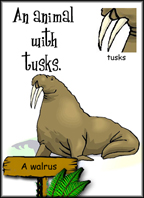Flashcards for teaching about animal behaviour


Home | Crosswords | Word Searches | Flash Cards | Verbs | Songs | Creative Writing | Work Sheets | Phonics | ABCs ESL Science | Potion Book | Spell Book | ESL for Adults | Ask Thomas | Lesson Plans | Holiday Worksheet | ESL Jobs
Quick Reference:
What's the difference between antlers and horns?
They are both extensions of the skull plate, but an antler is shed every year and grows back. A horn does not shed and will not grow back if broken.
What's the difference between tusks and horns?
A horn is an extension of the skull plate, but a tusk is actually a tooth extending out of the animal's mouth.
Animal Body Parts Flashcards

Animal Body Parts Flashcards
At present, there are forty-five animal body parts cards in all in the fifteen categories.
Make two copies of each card for a total of 90 cards. Students can play the game of fish to practice using the vocabulary. Though, you don't have to use all of the cards at once if you don't want to.
There are two basic dialogues for playing fish. It doesn't really matter which dialogue you use.
Dialogue structure 1:
A: Do you have an animal with tusks?
B: Yes, I do. (No, I don't. Go fish.)
A: Is it a walrus?
B: Yes, it is. (No, it isn't. Go fish.)
Dialogue structure 2:
A: Does your animal have antlers?
B: Yes, it does? (No, it doesn't. Go fish.)
A: Is it an elk?
B: Yes, it is. (No, it isn't. Go fish.)
With the new additions to the cards (beaks, fangs, feathers, and tails) you might want to use two animals from each set, or choose only animal traits that you want to focus on.
For ideas on how to use these cards visit the ESL Flashcards section, and to see more cards, check out the Flashcard Gallery.
Newly Added:
These cards go well with the animal behaviour cards, which teach language such as nocturnal, migratory, aquatic, extinct, and endangered.
.Also check out the Animal Kingdom Describe and Compare Game.